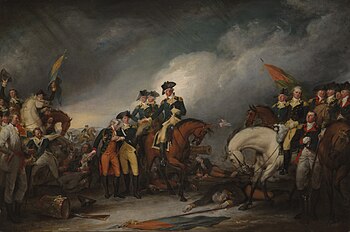
The Battle of Trenton was a small but pivotal American Revolutionary War battle on the morning of December 26, 1776, in Trenton, New Jersey. After General George Washington's crossing of the Delaware River north of Trenton the previous night, Washington led the main body of the Continental Army against Hessian auxiliaries garrisoned at Trenton. After a brief battle, almost two-thirds of the Hessian force were captured, with negligible losses to the Americans. The battle significantly boosted the Continental Army's waning morale, and inspired re-enlistments.

John Trumbull was an American artist of the early independence period, notable for his historical paintings of the American Revolutionary War, of which he was a veteran. He has been called the "Painter of the Revolution".

The Battle of White Plains was a battle in the New York and New Jersey campaign of the American Revolutionary War, fought on October 28, 1776, near White Plains, New York. Following the retreat of George Washington's Continental Army northward from New York City, British General William Howe landed troops in Westchester County, intending to cut off Washington's escape route. Alerted to this move, Washington retreated farther, establishing a position in the village of White Plains but failed to establish firm control over local high ground. Howe's troops drove Washington's troops from a hill near the village; following this loss, Washington ordered the Americans to retreat farther north.

Count Carl Emil Ulrich von Donop was a Hessian colonel who fought in the American Revolutionary War. He died of wounds during the Battle of Red Bank.
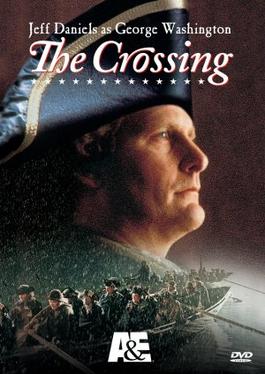
The Crossing is a 2000 American television historical drama film about George Washington's crossing of the Delaware River and the Battle of Trenton. Directed by Robert Harmon and adapted by Howard Fast from his novel of the same name, the film stars Jeff Daniels as George Washington. Also appearing are Roger Rees as Hugh Mercer, Sebastian Roché as John Glover, and Steven McCarthy as Alexander Hamilton. The film premiered on A&E on January 10, 2000.

George Washington's crossing of the Delaware River, which occurred on the night of December 25–26, 1776 during the American Revolutionary War, was the first move in a surprise attack organized by General George Washington, the commander-in-chief of the Continental Army, against Hessian forces garrisoned at Trenton, who were German mercenaries hired by the British. After crossing the Delaware River, Washington and his troops successfully attacked the Hessian forces in the Battle of Trenton on the morning of December 26, 1776. The military campaign was organized in great secrecy by Washington, who led a column of Continental Army troops from today's Bucks County, Pennsylvania across the icy Delaware River to today's Mercer County, New Jersey in what was one of the Revolutionary War's most logistically challenging and dangerous clandestine operations.
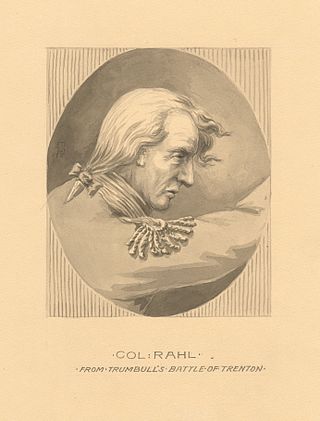
Johann Gottlieb Rall was a German colonel best known for his command of Hessian troops at the Battle of Trenton during the American Revolutionary War.

The Battle of the Assunpink Creek, also known as the Second Battle of Trenton, was a battle between American and British troops that took place in and around Trenton, New Jersey, on January 2, 1777, during the American Revolutionary War, and resulted in an American victory.

The Battle of Fort Washington was fought in New York on November 16, 1776, during the American Revolutionary War between the United States and Great Britain. It was a British victory that gained the surrender of the remnant of the garrison of Fort Washington near the north end of Manhattan. It was one of the worst Patriot defeats of the war.

The Battle of Iron Works Hill, also known as the Battle of Mount Holly, was a series of minor skirmishes that took place on December 22 and 23, 1776, during the American Revolutionary War. They took place in Mount Holly, New Jersey, between an American force mostly composed of colonial militia under Colonel Samuel Griffin and a force of 2,000 Hessians and British regulars under Carl von Donop.

The Battle of Trenton was fought on December 26, 1776, during the American Revolutionary War campaign for New Jersey. In a surprise attack, the Continental Army led by George Washington attacked the winter quarters of a brigade composed primarily of German troops from Hesse-Kassel in Trenton, New Jersey. The Hessian brigade was under the command of Colonel Johann Rall; he died of wounds sustained in the battle, and about two thirds of his men were taken prisoner. It was the first major victory after a long string of defeats that had resulted in the loss of New York City, and was a significant boost to American morale. It was followed by two more American victories, first in a second battle at Trenton on January 2, 1777, and then on January 3 at Princeton.
The 4th Continental Artillery Regiment, also known as Reign’s Continental Artillery Regiment, was an American military unit during the American Revolutionary War. The regiment became part of the Continental Army on 10 June 1777 as Colonel Thomas Proctor's Continental Artillery Regiment. It was made up of eight artillery companies from eastern Pennsylvania. At the time of the regiment's formation, two companies were already in existence, one from as early as October 1775. One company served at Trenton in December 1776 where it performed well in action. In February 1777, Pennsylvania expanded its two-company battalion into an eight-company regiment. After officially joining the Continental Army, the regiment saw much fighting in the Philadelphia campaign in late 1777. Elements of Proctor's Regiment fought at Monmouth in June 1778 and joined the Sullivan Expedition in summer 1779.
The "German Battalion" was an infantry formation of the Continental Army during the American Revolutionary War. Authorized in May 1776 as an extra Continental regiment, the battaltion recruited ethnic Germans from Maryland and Pennsylvania.
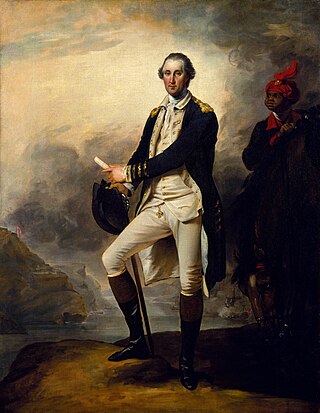
George Washington, also entitled George Washington and William Lee, is a full-length portrait in oil painted in 1780 by the American artist John Trumbull during the American Revolutionary War. General George Washington stands near his enslaved servant William Lee, overlooking the Hudson River in New York, with West Point and ships in the background. Trumbull, who once served as an aide-de-camp to Washington, painted the picture from memory while studying under Benjamin West in London. He finished it before his arrest for high treason in November. The portrait, measuring 36 in × 28 in, is on view in Gallery 753 at the Metropolitan Museum of Art in New York City. Originally in the possession of the de Neufville family of the Netherlands, it was bequeathed to the museum by Charles Allen Munn in 1924.

The Death of General Mercer at the Battle of Princeton, January 3, 1777 is the title of an oil painting by the American artist John Trumbull depicting the death of the American General Hugh Mercer at the Battle of Princeton on Friday, January 3, 1777, during the American Revolutionary War. The painting was Trumbull’s first depiction of an American victory. It is one of a series of historical paintings on the war, which also includes the Declaration of Independence and The Capture of the Hessians at Trenton, December 26, 1776.
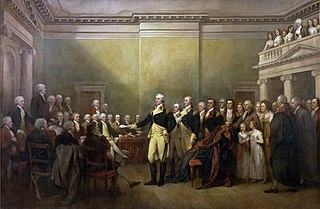
General George Washington Resigning His Commission is a large-scale oil painting by American artist John Trumbull of General George Washington resigning his commission as commander-in-chief of the Continental Army on December 23, 1783 to the Congress of the Confederation, then meeting in the Maryland State House at Annapolis, Maryland. The painting was commissioned in 1817, started in 1822, finished in 1824, and is now on view in the United States Capitol rotunda in Washington, D.C., along with three other large-scale paintings by Trumbull about the American Revolutionary War.

General George Washington at Trenton is a large full-length portrait in oil painted in 1792 by the American artist John Trumbull of General George Washington at Trenton, New Jersey, on the night of January 2, 1777, during the American Revolutionary War. This is the night after the Battle of the Assunpink Creek, also known as the Second Battle of Trenton, and before the decisive victory at the Battle of Princeton the next day. The artist considered this portrait "the best certainly of those which I painted." The portrait is on view at the Yale University Art Gallery in New Haven, Connecticut, an 1806 gift of the Society of the Cincinnati in Connecticut. It was commissioned by the city of Charleston, South Carolina, but was rejected by the city, resulting in Trumbull painting another version.

The Death of General Montgomery in the Attack on Quebec, December 31, 1775 is an oil painting completed in 1786 by the American artist John Trumbull. It depicts American general Richard Montgomery at the Battle of Quebec during the invasion of Quebec. The painting is on view at the Yale University Art Gallery in New Haven, Connecticut. It is the second in Trumbull's series of national historical paintings on the American Revolutionary War, the first being The Death of General Warren at the Battle of Bunker's Hill, June 17, 1775.

George Washington's reception at Trenton was a celebration hosted by the Ladies of Trenton social club on April 21, 1789, in Trenton, New Jersey, as George Washington, then president-elect, journeyed from his home at Mount Vernon to his first inauguration in the then capital of the United States, New York City. A ceremonial triumphal arch was erected on the bridge over the Assunpink Creek to commemorate his two victories here, the Battle of Trenton on December 26, 1776 and the Battle of the Assunpink Creek on January 2, 1777.

Abraham Hunt (1741–1821) was a wealthy American merchant and farmer in Trenton, New Jersey, first Postmaster of Trenton, and served in the American Revolutionary War as a Lieutenant Colonel in the Hunterton County militia. He was a prominent member of the First Presbyterian Church in Trenton. Early in the revolution he was a member of the Provincial Congress that held some of its sessions in Trenton. He played the host and placated the German Hessian commander Johann Rall before the Battle of Trenton. Suspected of duplicity for his accommodation to the Hessians, Hunt was charged with treason, but was acquitted and went on to serve in the cause for American independence. After the war, Hunt became involved in the politics and business interests of Trenton and New Jersey overall.
